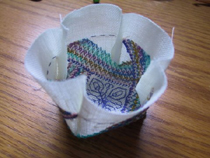When I finished my second pincushion I tested the directions I wrote up for the first one. They were horrible! So, the second time around I documented my progress. It's such fun testing my own patterns.
The pincushion started out flat, stitched with a square plus sign shape. It could also be rectangular, as long as the corners are an equal number of threads.
First is the creasing - both along the edges of the top of the box and at the bottom. As you can see in the top photo, I also creased the corners.
Now, trim the linen to about an inch to inch and a half past the stitching. Then, turn the pincushion face up and fold diagonally across the upper left corner.
With thread that matches the linen, go through the corner on the front and the back and come up two holes to the right on both sides. The basting stitches are very important here but can be removed as you go.
Keep going along over two and under two (running stitch). I had to check the front and back with each stitch to make sure both sides were aligned. When you get to the far right, turn around and stitch back.
(The picture I took here didn't turn out)
Once you get back to the start, tie a knot and end your thread. You can now pop the corner around to make sure everything lined up.
Pop the corner back around and repeat for the next 3 corners.
Now, you can trim the excess linen from the corners. I left just under a half inch.
Now, turn the pincushion right side out.
For the next step, you need to measure the top of the pincushion and cut squares of quilt batting slightly smaller than the top.
To be continued tomorrow ...








Comments
Post a Comment